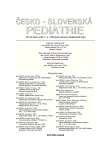Plenárne zasadanie – Spánková medicína
Vyšlo v časopise:
Čes-slov Pediat 2009; 64 (11): 519-520.
Sleep Disordered BREATHING (SDB) in children (Respiračné poruchy v spánku u detí)
Villa M. P., Crescenzi A., Castaldo R., Massolo A. C., Paolino M. C., Ianniello F.
Clinica Pediatrica, 2˚ Facoltà della Medicina e Chirurgia, Ospedale Sant Andrea, Università “La Sapienza”, Roma, Italia
Obstructive sleep-disordered breathing in children is a spectrum of disorders of breathing during sleep characterized by snoring and upper airway obstruction. In its most severe form, obstructive sleep apnoea, prolonged complete upper airway obstruction occurs, disrupting normal ventilation and sleep patterns. The hallmark feature of the disorder is habitual and loud snoring.
Primary snoring is characterized by frequent snoring without ventilatory abnormalities or obvious sleep disruption and affects 5–10% of children, while the more severe OSAS is characterized by hypoxia and sleep fragmentation in 1–4% of children. The peak prevalence of childhood OSAS occurs at 2–8 yr, which is the age when the tonsils and adenoid are the largest in relation to the underlying airway size and most children with OSAS improve following tonsillectomy and adenoidectomy. OSAS also occurs in children with upper airway narrowing due to craniofacial and structural anomalies (e.g. retrognathism/micrognathias, unilateral or bilateral crossbite, and open bit), or those with neuromuscular abnormalities such as hypotonia (e.g., muscular dystrophy) or muscular incoordination (e.g., cerebral palsy) or with obesity.
The clinical symptoms of SBD are heavy snoring, observed apnoeas, gasping for air leading to frequent arousals, disturbed sleep and daytime sleepiness. Children are often hyperactive and have learning and behaviour difficulties. Left untreated, obstructive sleep-disordered breathing may lead to problems related to sleep disruption such as inattention, poor learning, behavioural problems, and attention deficit/hyperactivity disorder or may cause more serious morbidity, including growth failure and cardiovascular disease.
Oxidative Stress has been involved in the pathogenesis of OSAS. After each episode of hypoxia/apnoea, reoxygenation occurs at both vascular and tissue levels, thus favouring the production of Reactive Oxygen Species (ROS) and leading to sub-clinical chronic inflammation, that conferred an additional risk of major neurocognitive, cardiovascular and metabolic consequences.
Given the multifactorial nature of the disorder there is no one-size-fits-all intervention for children with OSA. Most children with OSA improve after adenotonsillectomy (AT). However, AT is associated with surgical risks and may be unsuccessful in abolishing OSA in some patients due to other concurrent underlying factors. There is a number of adjunct or alternative interventions for paediatric OSA available such as anti-inflammatory drugs, weight reduction, continuous positive airway pressure (CPAP) or oral appliances (RME). Depending on the duration and severity of the symptoms, the anatomical and physiological findings, and the result of the PSG assessment, the practitioner has to choose which intervention will likely be most beneficial for the patient.
Spánkové poruchy dýchania u detí a možnosti ich diferenciálnej diagnostiky
Kuchta M.1, Donič V.2, Jura J.3, Tomori Z.2
1Klinika detí a dorastu LF UPJŠ a DFN Košice, Slovensko
2Ústav patologickej fyziológie LF UPJŠ Košice, Slovensko
3Ambulancia praktického lekára pre deti a dorast, ObZS Terchová, Slovensko
Úvod: Problematike syndrómu náhleho a neočakávaného úmrtia (SIDS) sme sa začali venovať začiatkom 80-tych rokov XX. storočia. Pri analýze týchto stavov sme sa sústredili najmä na ALTE (stav, ktorý temer ohrozil život). Od druhej polovice 90-tych rokov sme v rámci diferenciálnej diagnostiky ALTE a prevencie SIDS začali vykonávať diferenciálnu diagnostiku týchto stavov aj s využitím polysomnografie.
Cieľ práce: Retrospektívne zhodnotiť význam a miesto polysomnografie v diferenciálnej diagnostike spánkových porúch dýchania u detí za posledných 15 rokov.
Materiál a metódy: Aj s využitím polysomnografie vykonávame od roku 1994 program prevencie SIDS na Slovensku. V tejto súvislosti sme sledovali 124 súrodencov obetí SIDS, 289 detí s ALTE, u ktorých sme vykonali vyše 460 polysomnografií (systémom Nightwatch a Alice 3). Následne sme poskytli domáce apnoe monitory 121 rizikovým deťom s vyhodnotením ich účinnosti. V indikovaných prípadoch sme vykonávali diferenciálnu diagnostiku počas hospitalizácie na klinike, vrátane neurologického, gastroenterologického, kardiologického, ORL, metabolického a iných vyšetrení.
Výsledky: Pred zavedením programu prevencie do r. 1994 bol výskyt SIDS na Slovensku 0,57–1,3, až 3,5 ‰. Po zavedení programu v r. 1994 sa výskyt znížil pod 0,5 ‰ a od roku 2000 je trvalo pod 0,2 ‰. V diferenciálnej diagnostike ALTE sme kombináciou vyšetrení, vrátane polysomnografie, dospeli k odhaleniu možných etiologických činiteľov, ako sú napr. gastroezofágový reflux (GER), vrodené poruchy metabolizmu (napr. MCAD). Analýzou účinnosti domáceho apnoe monitoringu u rizikových dojčiat sme preukázali ich vysokú efektívnosť.
Záver: V diferenciálnej diagnostike apnoických stavov aj u najmenších detí je vhodné v indikovaných prípadoch použiť aj polysomnografiu, ktorá je dostupná i na špecializovaných pracoviskách na Slovensku. Pomocou nej je možná diferenciálna diagnostika porúch dýchania v spánku, stavov ALTE či sledovanie terapeutických efektov.
Štítky
Neonatologie Pediatrie Praktické lékařství pro děti a dorostČlánek vyšel v časopise
Česko-slovenská pediatrie

2009 Číslo 11
- Horní limit denní dávky vitaminu D: Jaké množství je ještě bezpečné?
- Isoprinosin je bezpečný a účinný v léčbě pacientů s akutní respirační virovou infekcí
- Syndrom Noonanové: etiologie, diagnostika a terapie
Nejčtenější v tomto čísle
- Ošetrovateľstvo II.
- Ošetrovateľstvo I.
- PEDIATRICKÁ GASTROENTEROLÓGIA, HEPATOLÓGIA A VÝŽIVA
- Pediatrická nefrológia
